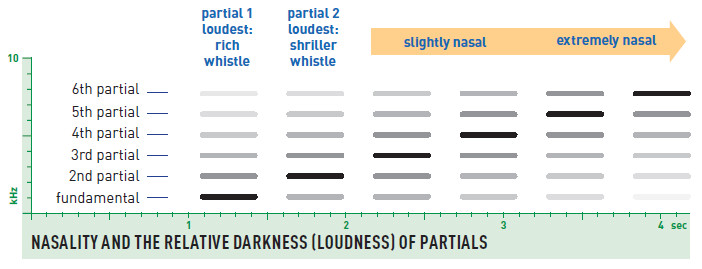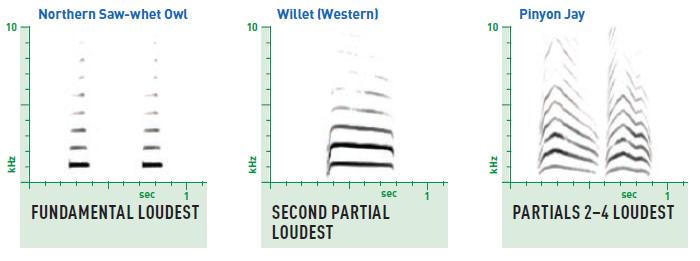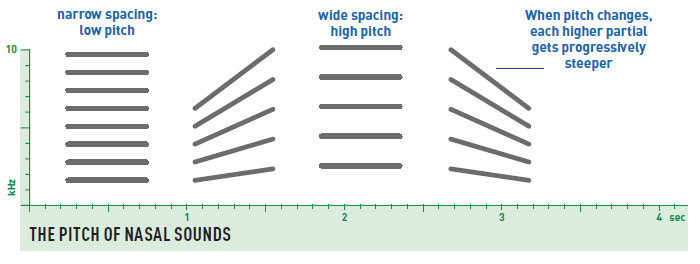Noisy sounds
(Peterson Field Guide to Bird Sounds, interactive version of pp. 20-22)
Darker is louder
The darker a note appears on the spectrogram, the louder it is. In noisy sounds, the pitch and pitch pattern are determined by the placement and shape of the darkest (and thus the loudest) parts of the noise. If the darkest part of the sound is closer to the top of the spectrogram, the noise will sound higher in pitch. If the darkest part rises toward the end of the spectrogram, the noise will sound upslurred; if it falls, the noise will sound downslurred.
Black-tailed Gnatcatcher:
Nasal sounds
Many bird sounds are actually combinations of multiple simultaneous whistles on different pitches that the human brain typically perceives as a single sound. The individual whistles that make up a complex sound of this kind are called partials. The first (lowest) partial is often called the fundamental.
 All nasal sounds are stacks of partials, but not all stacks of partials sound nasal. The tone quality of a complex sound depends on which partials are loudest—that is, darkest on the spectrogram.
All nasal sounds are stacks of partials, but not all stacks of partials sound nasal. The tone quality of a complex sound depends on which partials are loudest—that is, darkest on the spectrogram.
The higher the darkest line in a stack, the more nasal the sound
If the fundamental or the second partial is the loudest (darkest), then the call will not sound nasal at all, but whistled. Once the darkest band climbs as high as the third partial, the call will start to sound nasal, and the higher it climbs, the more nasal the tone quality, as the following graph illustrates.
 The six bird sounds below are arranged in order of increasing nasality; the higher the loudest (darkest) partial, the more nasal the sound. Note that the counting of partials starts at the fundamental even if it is too faint to appear on the spectrogram. This is because in nasal sounds, the numbering of the partials is determined by the mathematical relationship between their frequencies: the frequency of the second partial is twice that of the fundamental, the frequency of the third partial is three times that of the fundamental, and so on.
The six bird sounds below are arranged in order of increasing nasality; the higher the loudest (darkest) partial, the more nasal the sound. Note that the counting of partials starts at the fundamental even if it is too faint to appear on the spectrogram. This is because in nasal sounds, the numbering of the partials is determined by the mathematical relationship between their frequencies: the frequency of the second partial is twice that of the fundamental, the frequency of the third partial is three times that of the fundamental, and so on.
Willet (Western):
Pinyon Jay:
Red-breasted Nuthatch:
California Gnatcatcher:
The farther apart the stacked lines, the higher the pitch
The key to gauging the pitch of a nasal sound is the spacing between the partials. The farther apart the partials, the higher the pitch of the sound. If the partials stretch to the top and bottom of the spectrogram, counting them is helpful in estimating pitch. High sounds with three to five visible partials have a distinctive seminasal tone quality.
The voices of large birds often break
The voices of large birds, such as geese, hawks, gulls, shorebirds, and woodpeckers, may jump suddenly to a higher or lower pitch. In nasal sounds, voice breaks appear on the spectrogram as vertical “fault lines” along which the stripes of the partials don’t match up.
Red-shouldered Hawk:





